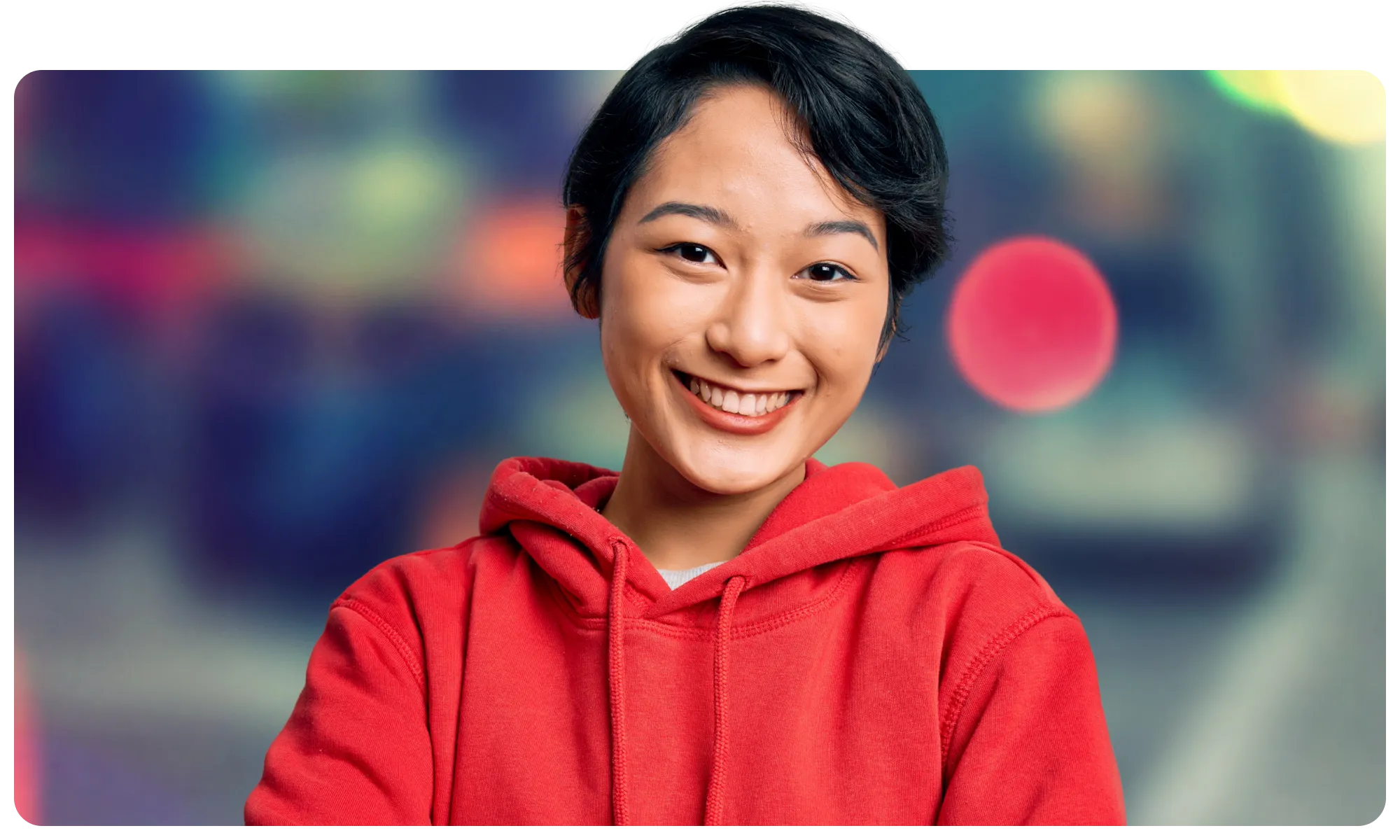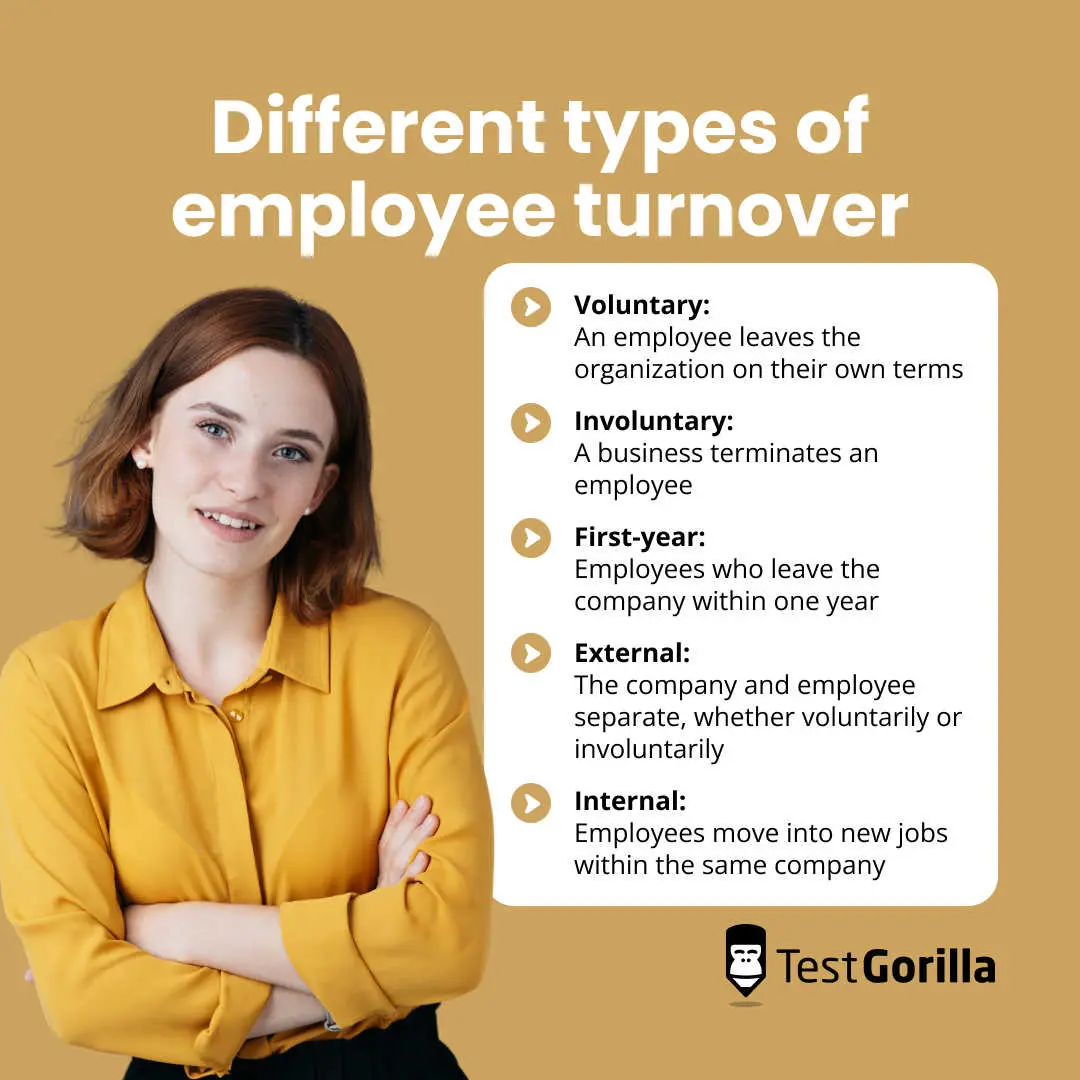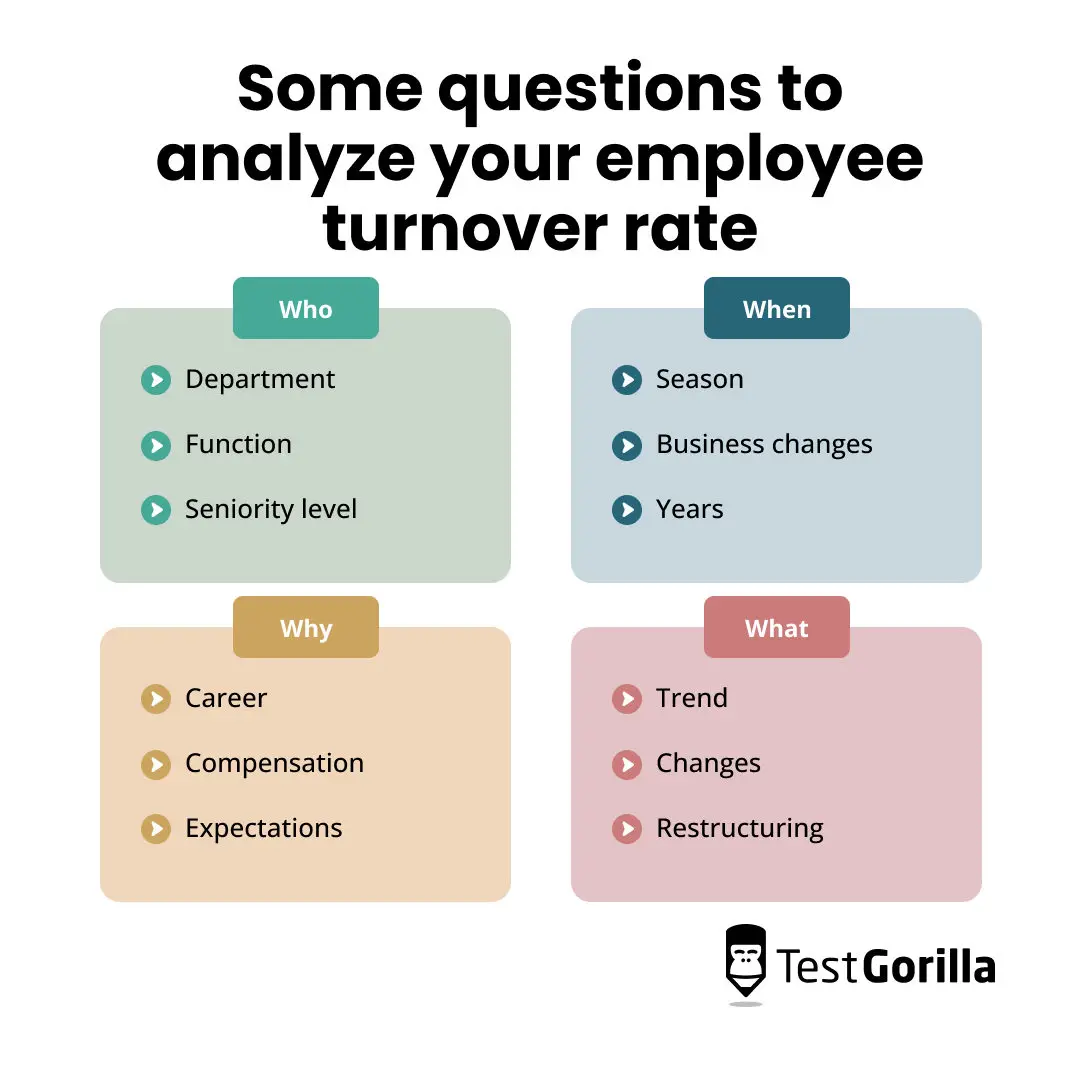Sometimes, you don’t notice problems with employee turnover until it’s too late. You’re snowed under with emails about urgent vacancies, sifting through applications from motivated candidates, all while wondering: How did we get here?
However, employee turnover rate doesn’t need to be a guessing game.
With the right data, you can calculate this rate so that you aren’t caught off-guard by sudden spikes in turnover. This information can also tell you which employee retention trends can help right the ship and keep your top talent onboard.
By calculating, analyzing, and acting on the information you glean from your staff turnover rate, you can not only prevent disruptions to your business but also boost productivity and employee wellbeing.
In this blog, we discuss the employee turnover rate formula, plus 37 employee retention strategies and how they can reduce your employee turnover rate.
Table of contents
- What is employee turnover rate?
- How do you calculate staff turnover rate?
- Different types of employee turnover, different turnover rate formulas
- What is a healthy turnover rate?
- How to analyze your employee turnover rate
- How to reduce your employee turnover rate: 37 tactics to implement in your organization
- Start reducing your employee turnover rate by hiring for skills
What is employee turnover rate?
Employee turnover refers to employees leaving their roles with an organization. This might be for another role with the same employer (internal turnover) or for a role at another company (external turnover).
The employee turnover rate refers to the proportion of workers leaving their roles in any given period.
Employee turnover rate vs. employee retention rate
If the turnover rate refers to the percentage of employees who are leaving their roles, the employee retention rate refers to the percentage of employees who stay in their roles throughout a given period.
The employee retention rate is almost always the inverse of the employee turnover rate. For example, a business with 20% turnover would have an 80% retention rate.
The only times when this might change is when you experience attrition – speaking of which…
Employee turnover rate vs. employee attrition rate
Turnover and attrition refer to a similar phenomenon. The word “turnover” is usually used to refer to employees leaving roles that the employer intends to refill after they leave, whereas attrition refers to the loss of employees whom you do not intend to replace.
Attrition doesn’t happen in only one way. It occurs whenever employees quit, are fired, or are made redundant.
Your employee attrition rate, therefore, is the percentage of employees who leave your company that you don’t intend to replace.
Why calculate your employee turnover rate?
We all know that turnover is inevitable in businesses. What benefits come from calculating the rate at which it’s happening?
It can be an indicator of the health of your company culture. Calculating your employee turnover rate helps you diagnose underlying organizational issues, whether they’re due to culture, benefits, development opportunities, or other causes.
It may explain the challenges you face in your business. For example, a key team might be underperforming because of a revolving door of employees.
Employee turnover rate data can help you justify HR initiatives to leaders. If you can prove your wellbeing initiatives reduce turnover, for instance, they may be more likely to renew your budget.
How do you calculate staff turnover rate?
To calculate turnover rate, we need to make some important distinctions between types of workers.
Type | Definition |
Employees | Any worker who received a payroll payment in the given period, but did not start their employment during that time |
Hires | Workers who started their employment within the given period; i.e., they did not receive payroll payment before this period |
Terminations | Workers who ended their employment within the given period; i.e., those who will not receive payroll in the next period |
These distinctions help to avoid counting the same worker twice – for instance, if they resign in one quarter but finish serving their notice in the next quarter.
Option 1: Excluding new hires
One popular employee turnover rate formula is as follows:
Employee turnover rate in a given period of time = number of workers who leave during period / number of workers at the beginning of the period × 100
This method of employee turnover rate calculation is recommended by international standards organizations.
Let’s say you want to calculate the turnover rate for the first quarter of the year.
| January | February | March |
Original employees | 150 | 130 | 110 |
Number of departing employees | 20 | 20 | 20 |
Number of new hires | 30 | 30 | 20 |
Total number of employees | 160 | 170 | 170 |
In this example, there are 60 total departing employees, out of 150 at the start of the period.
The employee turnover rate formula is (60 ÷ 150) × 100. This makes for a 40% staff turnover rate.
Option 2: Including new hires
There is another employee turnover rate formula:
Annual employee turnover rate = number of workers who leave that year / average number of employees for each of the months × 100
In the above example:
Total departing employees = 60
Average number of employees per month = 166
Employee turnover = 36%
This calculation for employee turnover rate is good for capturing broader trends, for instance, if you’re comparing your turnover rate over many years. However, you may lose some nuance.
How to calculate employee turnover rate: Examples
Here are two more examples of how to calculate employee turnover rate using each employee turnover rate formula.
Example 1
Your organization has 300 employees. In the past six months, 30 employees have handed in their notice, and 20 have been made redundant. You’ve also hired 25 new people.
Using option 1 for calculating employee turnover rate, divide the number of departing employees by the original number of employees.
That’s (50 ÷ 300) × 100, which makes for an employee turnover rate of 16%. Remember that when using the first option for calculating the turnover rate, the number of new hires is irrelevant.
Example 2
Let’s say your company has 250 employees, and you want to examine the employee turnover rate for the past six months using the employee turnover rate formula in option 2.
Here are the figures you’re working with:
| January | February | March | April | May | June |
Employees at start of month | 250 | 255 | 260 | 260 | 260 | 255 |
Departing employees | 15 | 10 | 15 | 10 | 15 | 10 |
Hires | 20 | 15 | 15 | 10 | 10 | 15 |
Total employees | 255 | 260 | 260 | 260 | 255 | 260 |
In this example, we’ve decided to use option 2, where the number of new hires counts towards your employee turnover rate.
Take the total number of departing employees (75) and divide it by the average monthly total of employees, including new hires (258), then multiply by 100. The result is a 29% turnover rate.
Different types of employee turnover, different turnover rate formulas
So far, we’ve covered how to calculate the turnover rate for your overall workforce.
But this number doesn’t tell us much on its own. The more context you put around the data, the more it helps you pinpoint if you’ve got a healthy turnover rate or if there may be internal problems.
Which types of turnover you look at depends on your priorities, and there are many to choose from. To start with, however, you should know four main types of turnover and how to calculate them.
Voluntary turnover rate
Voluntary turnover occurs when an employee leaves the organization on their own terms. Examples include people who leave to get new jobs in other industries, move locations, or increase their salaries.
To calculate the voluntary turnover rate, replace “number of overall departing employees” in the above formulas with “number of voluntary departing employees.”
If 60 people left a business of 250 people, but only 20 of them left voluntarily: (20 ÷ 250) × 100 = 8% voluntary turnover rate.
Involuntary turnover rate
The same goes for the involuntary turnover rate. Involuntary turnover happens when a business terminates an employee. Examples include layoffs, dismissals due to poor performance, or violation of regulations leading to termination.
In the above example, if the 40 remaining people who left were dismissed, the involuntary turnover rate would be:
(40 ÷ 250) × 100 = 16% involuntary turnover rate.
As you can see, the involuntary turnover rate (16%) and voluntary turnover rate (8%) add up to the total overall turnover rate (24%).
First-year turnover rate
The first-year turnover rate refers to turnover among employees who have been with your company for less than a year.
The formula for first-year turnover rate is:
Number of new hires who left within one year ÷ number of overall separations × 100
External turnover rate
External turnover is when the company and employee separate, whether voluntarily or involuntarily. It is different from internal turnover, which is when employees move into new jobs within the same company.
Internal turnover can be a positive thing for your business and boost retention, so we focus on reducing harmful external turnover in this blog.
What is a healthy turnover rate?
Employee turnover isn’t always undesirable. Dismissing employees who perform poorly, don’t match the company culture, or display toxic behavior is known as desirable turnover.
This type of turnover can be great for HR teams because it creates an opportunity to hire new employees who:
Are a better fit for the role
Can increase revenue
Can give the company a competitive advantage
A healthy turnover rate is one that leaves room for desirable turnover without creating a deficit of necessary skills.
Regularly assessing your employee turnover rate and comparing it to your key business metrics is one way of working out what is healthy for your organization.
Another is to check regional metrics or the employee turnover rate by industry. These are widely available online. For example, the Mercer turnover surveys for the US and Canada provide employee turnover statistics, as does the U.S. Bureau of Labor Statistics.
These surveys show the average employee turnover rate in the US in 2023 was 17.3%, with resignations being more common than terminations.[1]
How to analyze your employee turnover rate
Knowing how to figure out the employee turnover rate for your business is only half the battle; you now need to mine actionable insights from this data.
Here’s how.
Who is leaving your organization?
Calculate turnover rates for different types of employees, for example, separating them by:
Department
Function
Seniority level
Location
This helps you see if turnover is high in particular areas. The Mercer survey shows that different functions have different average employee turnover rates:[1]
Creative, Design, and Media: 3.1%
Executives: 5.1%
Customer Service and Contact Center Operations: 8.9%
Sales, Marketing, and Product Management: 10.0%
When are they leaving?
Next, look at when these employees are leaving, for instance:
When in the year they’re leaving. Are there seasonal resignations?
How their timing relates to recent business changes like new management or restructuring
After how many years of employment they’re leaving
Calculating the first-year turnover rate is handy here. If this figure is high, you can dig down further to find out when this happens.
For instance, are employees leaving during their probation period, suggesting a problem with your hiring process leading to costly mis-hires?
Why are they leaving?
With this information under your belt, investigate why employees are leaving. The most popular reasons for quitting, according to McKinsey research, are:
Lack of career development and advancement
Inadequate total compensation
Uncaring and uninspiring leaders
Lack of meaningful work
Unsustainable work expectations[2]
What is the trend in your employee turnover rate?
Finally, map your employee turnover rate calculations onto a graph to see whether there is an overall trend emerging.
For example, if there was a spike around a period of restructuring, has that now settled back to normal?
You can even use HR tools like Leapsome to project past trends forward into the future.
How to reduce your employee turnover rate: 37 tactics to implement in your organization
We’ve examined the reasons for voluntary turnover above; below, we discuss tips for reducing voluntary turnover that address many of these causes.
From what to do once you’ve identified an issue with your staff turnover rate, to rebuilding your team, to measuring outcomes, here are 37 tactics to reduce a high employee turnover rate.
37 tips for how to reduce your staff turnover rate: Summary table
Wherever you are in the process of managing your employee turnover rate, here’s a summary to help you find relevant tips.
How to reduce your turnover rate: tips | Example actions |
Diagnosing the issue | |
1. Conduct exit surveys with departing employees | Conduct exit surveys with all departing employees, not just the ones you want to return |
2. Initiate one-on-one meetings with employees in high-turnover teams | Ask employees’ opinions on why turnover is so high |
3. Set up long-term systems for employee feedback | Implement anonymous reporting tools to create safe routes for constructive feedback |
4. Use this feedback to identify employee flight risks | Look at employees in the same teams or compensation bands as recent departures |
Committing to change | |
5. Enshrine inclusivity in your organizational values | Demonstrate diversity and inclusion as core company values and build an inclusive culture |
6. Train leaders to communicate these values | Encourage leaders to role model desirable behaviors, such as self-compassion |
7. Make improving employee experience a priority among leaders | Add a chief experience officer to your senior leadership team |
8. Broadcast these changes to employees and online | Announce employee experience policy changes in internal communications and recruitment marketing |
Rebuilding your team | |
9. Switch to skills-based hiring to hire the right people | Evaluate candidates using skills assessments targeted at key competencies |
10. Use skills-based hiring to maximize diversity | Use skills tests instead of resume screening to limit bias in hiring |
11. Provide diversity training to all managers | Train managers to spot microaggressions in the workplace |
Creating incentives for employees to stay | |
12. Overhaul your employee compensation plan | Implement pay transparency and skills-based compensation |
13. Complement this with a strong employee benefits program | Include healthcare and retirement plans, which are high-priority for employees |
14. Start by implementing flexible working | Implement a “flexitime” schedule |
15. Design a range of incentives to manage engagement and performance | Start a peer-to-peer recognition program and an employee of the month initiative |
16. Ensure all age groups can benefit from these programs | Balance perks for younger workers with benefits for older workers, such as menopause support |
Improving employee experience | |
17. Create a strategy to address employee work life balance | Designate certain days as company-wide meeting-free days |
18. Include provisions for employees’ mental health | Train employees from each department as mental health first-aiders |
19. Ask employees what wellbeing initiatives they need | Circulate regular surveys about the company’s benefits offering |
20. Draw up a clear remote work policy | Set guidelines around screen time for remote employees |
21. Implement a phased retirement plan | Use phased retirement to manage handover to the retiring employee’s replacement |
Building employees’ skills | |
22. Start building skills during the onboarding process | Use skills test data to strengthen weak areas of employees’ skill sets |
23. Give employees a budget to pursue training programs | Give 3% of an employee’s annual salary for spending on training programs of their choice |
24. Use employee coaching to develop leadership potential | Pair candidates with high scores on leadership skills tests with management coaches |
25. Consult talent assessment data to identify candidates for upskilling | Test candidates on additional skills and offer training in areas where they show potential |
26. Use talent assessment data to spot candidates with adjacent skills | Test marketing employees for presentation skills to see if they could switch to sales |
Facilitating career growth | |
27. Inform employees about avenues for career growth | Brief new employees on the potential paths to promotion in their role during onboarding |
28. Discuss career growth during onboarding | Let employees know you understand their career goals may take them out of your company at some point |
29. Create a professional development plan for each employee | Create a training plan that meets employees’ goals and your skills needs |
30. Set up an internal mobility task force | Recruit representatives from each department to spot candidates for internal promotion |
31. Use an internal talent marketplace to facilitate internal hiring | Input skills test data into a database you can “shop” when considering candidates for new roles |
32. Try a job rotation program for entry level roles | Rotate entry-level employees between different functions in one department to try out different specialisms |
Measuring outcomes | |
33. Continuously assess employee engagement | Compare employee benefits usage, employee performance, and qualitative evaluation of the five factors of employee engagement |
34. Use employee listening tools to collect spontaneous feedback | Use an “always-on” feedback tool to collect spontaneous insights |
35. Conduct stay interviews with employees | Combine stay interviews with yearly performance reviews |
36. Use upward feedback to communicate employees’ needs to management | Institute a reverse mentoring program pairing senior leaders with junior employees |
37. Apply HR analytics to make projections for the future | Collect all your data into HR analytics software to generate trend forecasts |
1. Conduct exit surveys with departing employees
So you’ve analyzed your employee turnover rate and determined the team with the highest disruption.
Conduct an exit survey or interview asking departing employees about what prompted their resignation and how you can improve future employees’ experiences.
Remember to solicit feedback from all departing employees, not just the ones you’re sad to see go!
2. Initiate one-on-one meetings with employees in high-turnover teams
Next, turn your attention to remaining employees. Schedule one-on-one meetings to discuss the recent turbulence in their team.
In this meeting, you should discuss:
Why they think the turnover rate has spiked
Their intentions for their role
How you can support them to stay on board
3. Set up long-term systems for employee feedback
A turnover problem doesn’t go away after just a few meetings: You need to implement a long-term system for collecting employee feedback and acting on it.
Especially in teams where you suspect toxic dynamics might be at play, consider offering an anonymous reporting feature to ensure that employees have safe avenues to share honest feedback.
4. Use this feedback to identify employee flight risks
With the insights gleaned from these initial inquiries, you should now be able to identify employee flight risks.
These may be employees who share characteristics with recent departing employees, such as their manager or compensation package.
You could consider buying more time with a retention bonus. However, this is a short-term strategy – to properly address a high turnover rate, strive for long-term change.
5. Enshrine inclusivity in your organizational values
The McKinsey study above shows that more than a quarter of people leave their jobs because of an unsupportive work environment.
Creating an inclusive culture should, therefore, be a top priority when fixing your turnover rate because it plays a key role in boosting employee satisfaction.
Start by enshrining inclusivity as one of your core company values to demonstrate your intentions to employees.
6. Train leaders to communicate these values
Next, use leadership communication to convey your company values to employees.
Encourage leaders to role model desirable behaviors. One study found that leaders who role model self-compassion bring positive outcomes to their teams.[3]
This isn’t limited to executives, either. It was particularly powerful for managers lower down the company structure.
7. Make improving employee experience a priority among leaders
Of course, leadership communication is only half of the battle. Improving the employee experience to retain your top performers also requires strategic action.
One way that organizations show their commitment to their values is by adding a chief experience officer to their leadership teams, to lead the charge on retention initiatives.
8. Broadcast these changes to employees and online
These changes cannot impact your employee turnover rate unless employees know about them.
Shout about policy and personnel changes like hiring a chief experience officer in written communications with employees and in your outward recruitment marketing.
This improves your overall corporate reputation, making employees proud to work for you and more likely to stay long-term.
9. Switch to skills-based hiring to hire the right people
When rebuilding your team or patching gaps in a high-turnover workforce, hiring the right people is essential.
Without necessary skills on the team, existing employees are likely to burn out and quit themselves; a poor fit is also likely to leave after a short time.
Use skills-based hiring to ensure that all new hires have the key skills needed for their roles. Almost 90% of organizations see annual turnover rates fall after implementing skills-based hiring.
10. Use skills-based hiring to maximize diversity
Skills-based hiring brings objectivity to hiring, promoting diversity in the workplace.
Indeed, the number of women hired into senior roles increases by almost 70% when skills-based hiring is used.
This impacts your staff turnover rate: Research from Catalyst shows that higher levels of gender diversity are linked to lower employee turnover.[4]
11. Provide diversity training to all managers
Skills testing during hiring can’t shift bias in the workplace by itself. Tackle it by providing diversity training to all managers.
This helps managers avoid alienating marginalized employees, along with enabling them to:
Spot microaggressions in the workplace
Address diversity issues and advocate for diverse employees
Support marginalized employees to feel empowered at work
12. Overhaul your employee compensation plan
The number one factor influencing employees to quit is the need to make more money.[5]
If you don’t already have a strategic employee compensation policy in place, create one. It should be as transparent as possible, promoting pay transparency and applying clear logic, such as skills-based compensation.
13. Complement this with a strong employee benefits program
If you don’t have a bottomless budget for salary packages, don’t worry: No employment incentive package is complete without employee benefits.
Three-quarters of employees say their benefits package is an important factor in whether they stay with their employer, with retirement and healthcare plans gaining increasing importance. These benefits are worth their weight in the long run because they reduce needless turnover costs.
14. Start by implementing flexible working
One of the first benefits to consider is flexible working. Flexible and remote roles have lower employee turnover rates, with fully remote roles set to have the lowest turnover rate in 2023 compared to hybrid and in-person roles.[6]
In fact, 72% of office workers say they would choose long-term flexibility over a higher salary.[7]
15. Design a range of incentives to manage engagement and performance
Benefits usually apply to large groups of staff and are not related to performance, but you should also set up employee recognition programs to reward good work.
Simple initiatives like employee of the month schemes can foster strong engagement, which is key to decreasing turnover. Low-engagement teams have high employee turnover rates, up to 43% higher than highly engaged teams.[8]
Recognizing employees’ work is proven to make them less likely to look for a new job in the next three months.[9]
16. Ensure all age groups can benefit from these programs
Employee incentives lose their power when employees cannot use them. Ensure that no employees are left behind by your initiatives, including generationally diverse teams.
Perks like after-work beers or cycle-to-work schemes may benefit younger employees over older ones. Instead of eliminating these initiatives, balance them with benefits specifically for older workers.
One example is including menopause support on your healthcare plan, as Barclays Bank does.[10]
17. Create a strategy to address employee work life balance
Employees are 1.6 times more likely to stay with employers that offer wellness programs and benefits than those that don’t.[11]
Nurture employee work life balance and combat burnout without ballooning your budget by:
Setting company-wide meeting free days
Providing strong guidelines about out-of-hours emails
Offering “summer hours” for employees to get outside in good weather
18. Include provisions for employees’ mental health
When designing your employees’ health and wellbeing initiatives, it’s easy to focus on social perks and physical health benefits, but don’t neglect mental health in the workplace.
Offer mental health crisis support by training mental health first-aiders and give employees an allowance for mental health days.
19. Ask employees what wellbeing initiatives they need
A shocking number of employers waste money on benefits their workers don’t want or need. One study suggests there is an 83% gap between the employee wellbeing benefits employees have and the ones they want.[12]
This leads to wasted time and energy when employees neglect to use their benefits programs.
To ensure a return on your investment, regularly poll employees about which initiatives they want and use.
20. Draw up a clear remote work policy
Although more than 39% of flexible workers see a noticeable improvement in their mental health, remote work, in particular, can pose challenges such as:
Invasion of privacy
Role ambiguity
Lack of social support from colleagues
These all have a negative impact on mental health when unchecked.[13]
Create a clear remote work policy with guidelines for employees about looking after themselves while working remotely, for example:
Recommending screen breaks
Providing a comfortable home office setup
Subsidizing healthy lifestyle choices like a gym membership
21. Implement a phased retirement plan
Like we said above, you need to make sure you provide for older workers as well as for younger employees.
Do this by offering phased retirement plans. These help employees ease the transition out of the world of work and reduce employee turnover by minimizing disruption to affected teams.
22. Start building skills during the onboarding process
As we’ve seen, personal development trumps even compensation issues for employees.
Start investing in employees’ skills during the onboarding process. Use insights from their skills assessments to tailor their training – for example, have managers offer extra instruction in their weaker skill areas.
A positive onboarding experience can halve employees’ chances of looking for new opportunities in the near future.[14]
23. Give employees a budget to pursue training programs
Give employees control of their learning by providing them with their own budget to pursue employee training programs.
At TestGorilla, we award employees a budget equal to 3% of their annual salary to spend on skills training.
And it works. More than 90% of companies that introduce upskilling programs increase productivity and reduce employee turnover rates.
24. Use employee coaching to develop leadership potential
Formal skills training isn’t the only way for employees to learn. Employee coaching is also a low-cost option.
Unlike mentoring, which is relationship-focused and encourages mentors to draw insights or examples from their own careers to apply to their mentees, coaching is more structured and focuses on skill development, usually in pursuit of a specific goal.
Use it to nurture high-performing employees who score well on leadership skills, hitting employees’ desires for skill building and career development at the same time.
25. Consult talent assessment data to identify candidates for upskilling
Skills test data helps identify candidates for upskilling by showing you which employees have potential in areas not currently required by their role – for example, leadership and project management.
It pays to be proactive about this. Nearly 60% of the workforce already need new skills to do their jobs effectively; employers risk stressful skills gaps unless they act fast.
26. Use talent assessment data to spot candidates with adjacent skills
Skills test data also helps you spot employees with the adjacent skills necessary to move laterally into other roles.
This, in turn, enables you to offer reskilling opportunities, keeping valuable skills and institutional knowledge in-house.
Like with upskilling, we encourage proactivity here. Business leaders predict around 40% of their workforce requires imminent reskilling.
27. Inform employees about avenues for career growth
Employees don’t want to build skills for the sake of it. You need to back up skill-building with paths for career growth.
Inform all employees early in their employment of the paths for progression in their role and what’s required to advance. When they have a clear path forward, employees don’t need to look to competitors for advancement opportunities.
28. Discuss career growth during onboarding
Make it clear from the start of your working relationship that you understand employees’ careers may take them out of your company eventually, and that you still want to invest in their skills.
This creates a bond of trust that disincentivizes turnover, boosting job satisfaction and increasing the likelihood that departing employees will be generous when handing over to their replacements.
29. Create a professional development plan for each employee
Create professional development plans for each employee, combining the knowledge from their pre-employment skills tests and your early conversations about their career growth.
This shows employees you are investing time and effort in their personal growth. It also helps you plan their training to meet your business’s skill requirements.
30. Set up an internal mobility task force
Translate the above gestures into substantive action by setting up an internal mobility task force to spot candidates for internal promotion.
This is a committee of representatives from each department or team who get together to share knowledge about the skills you have in-house and identify potential internal hires for open roles.
31. Use an internal talent marketplace to facilitate internal hiring
Another way to maximize internal mobility opportunities is by inputting all employee skills test data into an internal talent marketplace.
This is a software or simple database containing a list of all the skills resources available in your business, which you can “shop” for candidates when a position becomes available.
32. Try a job rotation program for entry level roles
Broaden employees’ understanding of the roles within your organization by providing job rotation programs.
These are programs in which employees alternate between a series of different functions within the organization to test out different roles. They are usually at the same early-career level.
33. Continuously assess employee engagement
Measuring your employee turnover rate is not a “one-and-done” deal. You should continually reassess employee engagement metrics alongside your employee turnover rate.
That means looking at hard data like performance stats but also qualitatively evaluating the five factors of employee engagement:
Mindful hiring
A well-defined company culture
Involved employees
Inspirational leadership
Clear communication
34. Use employee listening tools to collect spontaneous feedback
Continuously assess employees’ responses to your initiatives using employee listening tools.
These might sound Orwellian, but they’re nothing more than simple survey tools and online feedback portals.
“Always-on” feedback tools collect spontaneous insights from employees, and although 64% of employers think they do the job well, just 20% of companies employ them.
35. Conduct stay interviews with employees
We started this list with exit interviews for when you’re managing a turnover crisis. Once your employee turnover rate has stabilized, turn your attention to stay interviews with employees.
You could couple these with yearly performance reviews, asking employees what’s keeping them in their role and if they need any additional support.
36. Use upward feedback to communicate employees’ needs to management
Feedback shouldn’t stop at line managers or HR personnel. To be truly effective, it should go all the way to the top. That’s where upward feedback comes in.
One way to implement upward feedback is through reverse mentoring schemes, where senior leaders are paired with junior employees to hear their thoughts on their management style.
37. Apply HR analytics to make projections for the future
Finally, make the most of the rich sources of data you’ve created with skills testing and employee feedback tools by compiling them within HR analytics software.
There are many types of human resources analytics designed specifically for managing turnover. These enable you to monitor turnover data and extract insights, even making projections for the future.
Start reducing your employee turnover rate by hiring for skills
We’ve covered a lot of ground here, running through:
The two types of employee turnover rate formula
What average employee turnover rates look like across industries
What is a good employee turnover rate for your business
How to fix a high staff turnover rate
The common thread throughout these tips is that supporting employees’ overall wellbeing and career growth is essential to keeping them around.
To find out more about how skills-based hiring can help you with this, read our blog about why skills-based hiring and employee development go hand-in-hand.
For a deep dive into how diversity positively affects your workforce, read our guide to the benefits of diversity in the workplace.
Finally, to ensure that new employees are in it for the long haul, use our Culture Add test to hire employees who add to your organizational culture.
Sources
1. “Results of the 2023 US and Canada Turnover Surveys”. (September 21, 2023). Mercer. Retrieved November 21, 2023. https://www.imercer.com/articleinsights/workforce-turnover-trends
2. De Smet, Aaron, et al. (July 18, 2022). “The Great Attrition is making hiring harder. Are you searching the right talent pools?”. McKinsey & Company. Retrieved November 21, 2023. https://www.mckinsey.com/capabilities/people-and-organizational-performance/our-insights/the-great-attrition-is-making-hiring-harder-are-you-searching-the-right-talent-pools
3. Lanaj, Klodiana, et al. (2022). “When leader self-care begets other care: Leader role self-compassion and helping at work”. Journal of Applied Psychology. Retrieved November 21, 2023. https://psycnet.apa.org/doiLanding?doi=10.1037%2Fapl0000957
4. “Why Diversity and Inclusion Matter (Quick Take)”. (June 24, 2020). Catalyst Research. Retrieved November 21, 2023. https://www.catalyst.org/research/why-diversity-and-inclusion-matter/
5. Mackenzie, Keith. “Is salary important to workers? Bet your bottom dollar it is”. Workable. Retrieved November 21, 2023. https://resources.workable.com/stories-and-insights/is-salary-important-to-workers-bet-your-bottom-dollar-it-is
6. Day, Amanda. (2022). “How to reduce employee turnover with a strong talent retention strategy”. Remote. Retrieved November 21, 2023. https://remote.com/blog/employee-turnover
7. “Why Employees Prefer Hybrid Working To A 10% Pay Rise – And What It Means For Business”. (September 13, 2021). International Workplace Group. Retrieved November 21, 2023. https://old.iwgplc.com/MediaCentre/Article/why-employees-prefer-hybrid-working-to-pay-rise
8. “The Benefits of Employee Engagement”. (January 7, 2023). Gallup. Retrieved November 21, 2023. https://www.gallup.com/workplace/236927/employee-engagement-drives-growth.aspx
9. Des Georges, Colette. "Can employee recognition help you keep them longer?". SurveyMonkey. Retrieved November 21, 2023. https://www.surveymonkey.com/curiosity/employee-recognition-and-retention/
10. “Diversity & Inclusion Report 2021”. (2021). Barclays. Retrieved November 21, 2023. https://home.barclays/content/dam/home-barclays/documents/investor-relations/reports-and-events/annual-reports/2021/Barclays-PLC-Diversity-and-Inclusion-Report-2021.pdf
11. “The Rise of the Whole Employee: 20 Years of Change in Employer-Employee Dynamics”. (2022). MetLife. Retrieved November 21, 2023. https://www.rbgcal.com/wp-content/uploads/2016/03/MetLife-Employee-Benefit-Trends-Study-2022.pdf
12. Yetman, Jill. (November 16, 2021). “Study: Canadian workplace health benefits critical for employee retention”. Telus. Retrieved November 21, 2023. https://www.telus.com/en/about/news-and-events/media-releases/canadian-workplace-health-benefits-critical-for-employee-retention
13. Oakman, Jodi, et al. (November 30, 2020). “A rapid review of mental and physical health effects of working at home: how do we optimise health?”. BMC Public Health. Retrieved November 21, 2023. https://bmcpublichealth.biomedcentral.com/articles/10.1186/s12889-020-09875-z
14. Bolden-Barrett, Valerie. (May 3, 2018). “New hires are twice as likely to leave employers that mishandle the onboarding process”. HR Dive. Retrieved November 21, 2023. https://www.hrdive.com/news/new-hires-are-twice-as-likely-to-leave-employers-that-mishandle-the-onboard/522384/
Related posts
Hire the best candidates with TestGorilla
Create pre-employment assessments in minutes to screen candidates, save time, and hire the best talent.
Latest posts
The best advice in pre-employment testing, in your inbox.
No spam. Unsubscribe at any time.

Hire the best. No bias. No stress.
Our screening tests identify the best candidates and make your hiring decisions faster, easier, and bias-free.
Free resources
This checklist covers key features you should look for when choosing a skills testing platform
This resource will help you develop an onboarding checklist for new hires.
How to assess your candidates' attention to detail.
Learn how to get human resources certified through HRCI or SHRM.
Learn how you can improve the level of talent at your company.
Learn how CapitalT reduced hiring bias with online skills assessments.
Learn how to make the resume process more efficient and more effective.
Improve your hiring strategy with these 7 critical recruitment metrics.
Learn how Sukhi decreased time spent reviewing resumes by 83%!
Hire more efficiently with these hacks that 99% of recruiters aren't using.
Make a business case for diversity and inclusion initiatives with this data.























